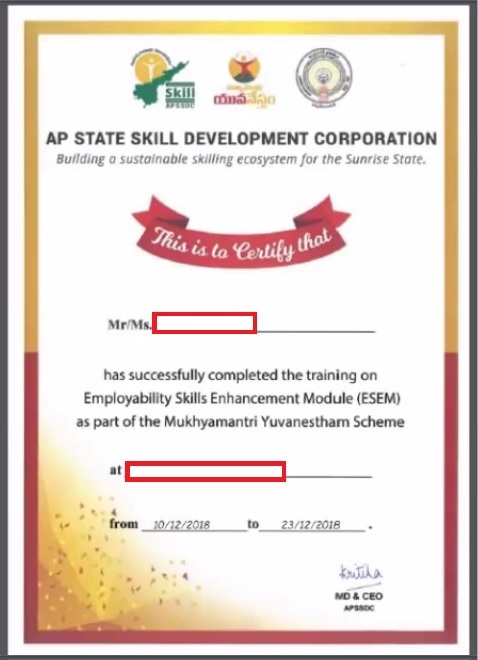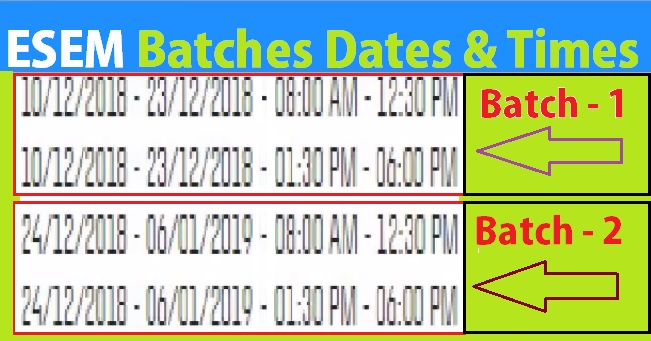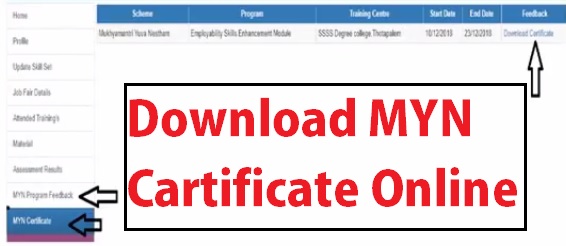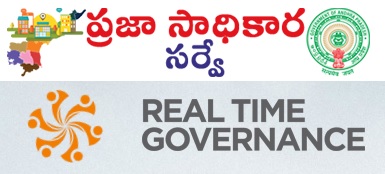We already know previously about Mukyamantri Yuvanestham (Nirudyoga Bruthi). So the candidates getting allowance in every month under Mukyamantri Yuvanestham Scheme, they also offer to get training in ESEM (Employability Skills Enhancement Module) programme on behalf of Andhra Pradesh State Skill Development Corporation (APSSDC). The period of raining is 14 days under your selected course. Finally they will conduct online exam on this training. So the eligible candidates will be get ESEM certificate.
Note : The 15days ESEM training completed and qualified in the online computer based test, candidates only can able to download their Mukyamantri Yuvanestham Certificate.

Andhra Pradesh State Skill Development Corporation (APSSDC)
Employ-ability Skills Enhancement Module Certificate Format

ESEM Batches
There are totally 4 batches successfully complete until now. The previous three batches dates and timings you can find below.

ESEM Online Test
After completion of 2 weeks (14days) Employability Skills Enhancement Module Training, the final day (on 15th Day) they will be conducted a online based test on the relevant syllabus. The candidates who complete this course successfully and qualified in the online based test, they will get certificate for the training completion.
Yuvanestham Certificate format
The provided Yuvanestham Certificate will be in PDF format. You can store the PDF file format certificate in your mobile / computer and email also.
How to download Mukyamantri Yuvanestham Certificate
Hi friends, you can follow the below given few simple steps in order to downloading of “Mukyamantri Yuvanestham Certificate”
- Open the website : https://yuvanestham.ap.gov.in/
- Click on Login button and enter the relevant details.
- Now you can access your profile
- Now click on “MYN Certificate” and download your certificate.
Note : Take a hard copy printout of Yuvanestham Certificate for further usage.
Procedure to downloading of MYN Certificate Online in PDF format (Screenshot)

Usages of Yuvanestham Certificate
- By submitting Yuvanestham certificate in job interviews, you will get weightage for your relevant further jobs
- Yuvanestham Certificate takes weightage in Job-Mela competitions within the state.
- You are very easy to apply for your relevant job in http://jobskills.apssdc.in/
- Find JobMela venue and date in http://jobskills.apssdc.in/ , apply for job and appear interview.
Note: The candidates who got trained by ESEM, you should update with the jobsskills portal i.e.: http://jobskills.apssdc.in/sdc/
Job Skills website : http://jobskills.apssdc.in/sdc/
Find training centres in your district at : http://jobskills.apssdc.in/sdc/DashBoard/unemployedYouthTrainings
Employability Skills Enhancement Module (ESEM) Study Material
Model Student Handbook Download in PDF format
For any queries regarding above topic, please tell us through below comment session. We will try to assist you.
